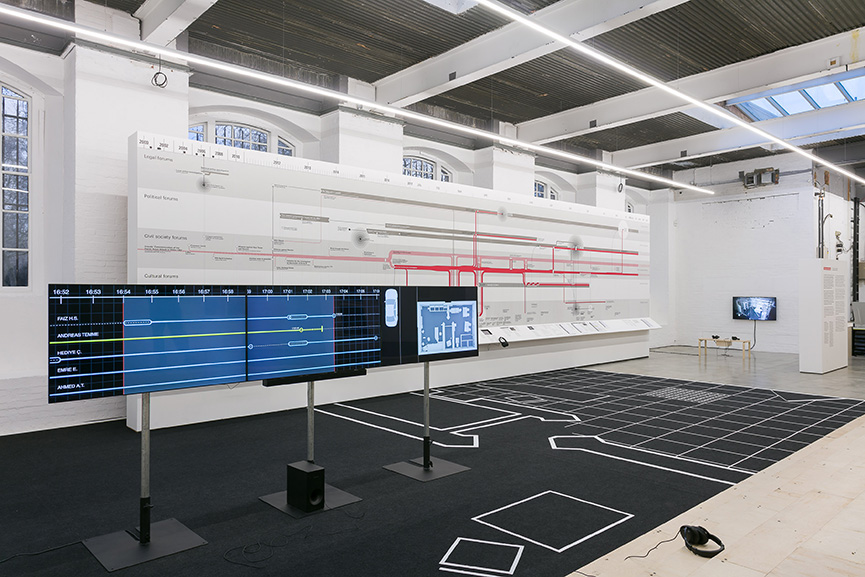[ad_1]
From September 25th 2018 through January 6th, 2019, Tate Britain will once again show the artworks of artists shortlisted for its prestigious Turner Prize. The museum has just announced the 4 names for the 2018 edition, one of which will take home £25,000 and will go down in history as the winner of one of the best-known art awards for visual arts in the world.
The members of the Turner Prize 2018 jury are Oliver Basciano, art critic and International Editor at ArtReview; Elena Filipovic, Director of Kunsthalle Basel; Lisa Le Feuvre, Executive Director of Holt-Smithson Foundation; and Tom McCarthy, novelist and Visiting Professor, Royal College of Art.
The jury is chaired by Alex Farquharson, Director of Tate Britain. Turner Prize 2018 is curated by Linsey Young, Curator, British Contemporary Art and Elsa Coustou, Assistant Curator, British Contemporary Art, Tate.
Alex Farquharson, Director of Tate Britain said:
Following a thoughtful and rigorous debate, this year’s jury has chosen an outstanding group of artists, all of whom are tackling the most pressing political and humanitarian issues of today. This shortlist highlights how important the moving image has become in exploring these debates. We are looking forward to what will be a dynamic and absorbing exhibition. We are very pleased to announce our new partnership with BNP Paribas whose generous support of the Turner Prize will allow us to give young people greater access to some of today’s most relevant and inspiring contemporary art.
The winner will be announced in December, at an awards ceremony which will take place live on BBC.
Forensic Architecture
An independent research agency based at Goldsmiths, University of London, Forensic Architecture has been pioneering methods for spatial investigations of state and corporate violations around the world, used in courts of law as well as exhibitions of architecture and art. The group includes filmmakers, architects, investigative journalists, software developers, scientists and lawyers.
The Turner Prize 2018 jury praised Forensic Architecture for their participation in documenta 14, and their solo exhibitions Counter Investigations: Forensic Architecture at the Institute of Contemporary Arts in London, Forensic Architecture: Towards an Investigative Aesthetics at MACBA Barcelona and Forensic Architecture: Towards an Investigative Aesthetics at MUAC Mexico.

Naeem Mohaiemen
Born in London and raised in Bangladesh, Naeem Mohaiemen investigates the legacies of decolonization and the erasing/rewriting of memories, following the period after World War II. His practice involves research, resulting in installations, films, and essays. The artist is currently undertaking a Ph.D. in Anthropology at Columbia University, USA.
Naeem Mohaiemen’s participation in documenta 14, as well as his solo exhibition titled Naeem Mohaiemen: There is No Last Man at MoMA PS1 in New York earned him the attention of the jury, whose members were struck by his narratives which combine fiction and social history to explore migration, exile, refuge and post-colonial identity – topics that are more than relevant at the moment.

Luke Willis Thompson
The Turner Prize 2018 jury particularly noted the meditative nature of Luke Willis Thompson’s black and white 35mm silent portrait of Diamond Reynolds, as part of his solo exhibition Autoportrait held at Chisenhale, London. Described as “a study of grief”, this work tackles the topics of police violence and race, as the artist invited Reynolds to produce an aesthetic response to the fatal shooting of her partner, Philando Castile, in a way as an addition to the broadcast she posted live via Facebook moments after Castile’s death.
The technique Thompson used is both an homage and a critique of Andy Warhol’s Screen Tests (1964-66).

Charlotte Prodger
Working with printed image, writing and sculpture, Charlotte Prodger is best known for working with moving image, which has been a part of her practice for two decades now.
Particularly, the BRIDGIT/Stoneymollan Trail solo exhibition at Bergen Kunsthall in 2017 featured two single-channel videos of eponymous names; the first is shot entirely on the artist’s iPhone, which she saw as a prosthesis or extension of the nervous system, and the other as a non-linear miscellany of visual material from her personal archive.

Featured image: Tate Britain © Lee Mawdsley. All images courtesy Tate Britain.
[ad_2]
Source link
